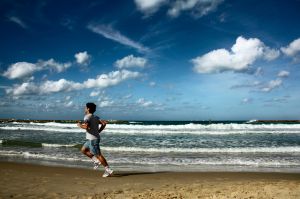
We are lucky to have beautiful beaches along the Treasure Coast of Florida. Take a look up and down the beach and, odds are, you’ll see someone running along the sandy shores as part of a fitness plan. Running on the beach seems like an ideal solution to enjoy a workout while taking in the scenery; however, the extra mileage on the sand might not suit you as well as you would’ve hoped. Below are a few pros and cons of running on the beach:What Are the Pros of Running on the Beach?
Can I Burn More Calories If I Run on the Beach?
Running on sand requires you to generate more force and engage in a fuller range of motion than running on asphalt. With each stride your feet sink into the soft sand increasing the “collision” time. This increase forces you to exert more energy; burning around 30% more calories.
Will Running On the Sand Build Strength?
Running on soft sand is more forgiving on the body. Taking advantage of a low tide with a hard-packed surface still offers runners a fulfilling workout without the hard impact on joints that asphalt or concrete gives. The increased effort required to run in the sand allows the muscles of your lower extremities, feet and back to work harder while simultaneously building more strength and stamina.
Are Outdoor Runs More Enjoyable Than Indoor Runs?
While running on the beach forces a more strenuous work out, research shows it actually makes you happier. The dynamics of avoiding beach animals, debris and sand dunes creates for a more enjoyable and unpredictable run as well. Studies detail that running outdoors generates significantly higher measures of vitality, enthusiasm, pleasure and self-esteem while simultaneously lowering tension, depression and fatigue.What Are the Cons of Running on the Beach?
Will Running On the Beach Affect Other Related Injuries?
Due to soft sand and unfamiliar stresses on feet and ankles, runners are more likely to experience other orthopaedic-related injuries on the beach. Plantar facilities, ankle sprains and overstretching the Achilles tendon are all possible results of missteps and improper footwear. The potential uneven surface may also transmit more stress to the ligaments of the knee possibly resulting in strain or sprain. You may also experience more stress on the hips and back resulting in aches or pains. To help reduce your risks of injury, incorporate 10-15 minute workouts then slowly add on 5-minute increments as your body becomes more accustomed to the different surface.
How Does Running On the Beach Affect A Workout?
As feet sink into soft sand and increase collision time, it becomes harder to power through a regular 30 minute workout. In other words, 10-minute miles feel like speed work. So, avoid fatigue and disappointment by adjusting your expectations and possibly consider running during a low tide when the sand is more even and compact. You will be getting more of a workout even at slower paces and in less time.
What Other Injuries Should I Be Aware Of While Running on the Beach?
To avoid dehydration and other heat related injuries, be sure to hydrate properly and make sure to always keep a fresh supply of water on hand. Avoid running when the sun is most intense between 10 a.m. and 4 p.m. and remember to apply a generous layer of SPF 30 to safely enjoy your run.
